SALTWATER CHRONICLES FLY FISHING ADVENTURES IN SALTWATER - Part 8
| Sysadmin Note |
|---|
| Part 7 can be found here |
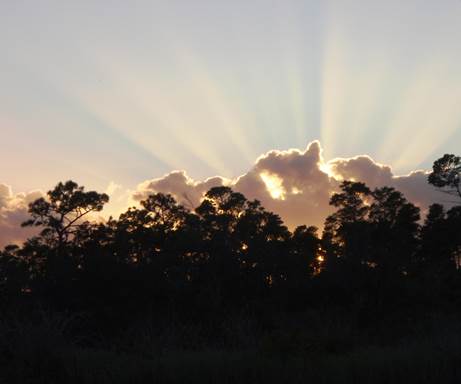
Saltwater Gamefish of the Sebastian Area
Now we will delve into the variety of Saltwater Gamefish found in the Sebastian area; this would include Sebastian Inlet, the Indian River and the St Sebastian River. There are simply a lot of gamefish for the saltwater fly angler to catch and from my perspective this abundance and variety is the perfect setting for the saltwater angler to learn the area and to become familiar and comfortable with saltwater fly fishing. If the angler is new to the sport they can find that a day on the water can be filled with many different experiences to be enjoyed besides the catching of the fish.
In this column we will start out with Jack's and Sailcats and I will cover the fish and the patterns that I have had success with along with tackle tips for the different times of the season.
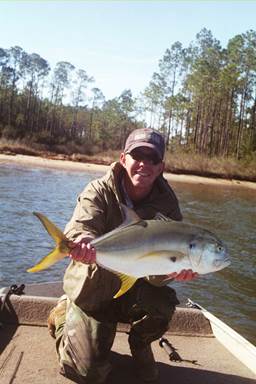
One of first fish I will discuss is the Jack Crevalle [Caranx hippos] they have a body shape similar to that of a Permit and are a powerful predatory fish eating a variety of small fish along with shrimp and crabs. They have a reputation for being an extremely strong and powerful fighter which is well deserved; as anyone who caught one will tell you.
They can live up to seventeen years and can attain forty inches in length and weight fifty five pounds and are found both inshore and offshore. They spawn offshore from March to September and the young fish head inshore upon hatching. They are found in lagoons, brackish water, over reefs and in saltwater river and all but the largest individuals will school.
You can often find schools of one to three pound Jacks and they will often take surface flies which endear them to me. Larger ones will also take poppers and sliders on the surface. As for tackle I always have a eight weight with a floating line and small popper rigged up and another rod with a type three sink tip rigged up with a minnow or shrimp imitation. The tackle that you choose will depend on the depth of the water you are fishing, the time of year and the water temperature. Over the years I have caught Jacks from one to thirty pounds and have never been disappointed by the fight or the excitement they offer.

The next fish that I would to discuss is Gafftopsail Catfish [Bagre marinus] which are commonly called "Sailcats" these fish are seldom written about and are largely considered a nuisance fish. However I am here to tell you that Sailcat will give you all the fight that you can handle. The research books will tell you that they can reach ten pounds but the average is two to three pounds, well the St. Sebastian River and the Indian River around Sebastian Inlet must be above average as we often catch six to eight pound Sailcats and have taken them as large as eleven and half pound. These are among the hardest and most tenacious fighters in the saltwater.
A Sailcats lifespan is between six and eight years and can exceed ten pounds in weight. They have long venomous spines which can cause a painful wound to the careless angler. They spawn from May to August over inshore mud flats, the males fertilizes the eggs of the female and then broods the eggs in his mouth until they hatch. During this period the males does not eat however the females are very hungry after spawning. Both young and adult Sailcats will school and a school of adults will flat wear out the angler.
These strong fighters feed throughout the water column and are common in lagoons, brackish water, flats, and mangroves and around piers where they feed on shrimp, crabs and smaller fish.
My first encounter with Sailcats took place on the St. Sebastian River many years ago in December on a fishing trip with my son Ryan.
The day was overcast with a light steady rain and the fishing during the morning was outstanding for Jacks, Ladyfish, small Tarpon and the occasional Spec all morning and into the early afternoon we had fished with floating lines and sink tips. During the later afternoon the fishing began to slow down and we switch to fishing type four full sinking lines and began to once again catch fish. Suddenly I hooked up with a powerful fish that just wouldn't give up and when I finally land the fish we had to grab to fish guide to figure out just what I had caught. At the time my son made the observation that this fish is all mouth. We later learned that a local name for this fish was Bigmouth Catfish. The odd part of this story is I then proceeded to hook and land six more of these Sailcats and my son was using the same type of fly line and fly could not seem to find them, all of the fish I had hook were between six and eight pound with one pushing nine and half pounds. Finally I hooked another and hand him the rod, as I was beat down and tired from fighting these bulldog fighter.
Sailcats may not be as glamorous as other speices but they will give you all the fight you want and as we found out they are pretty eating to boot.
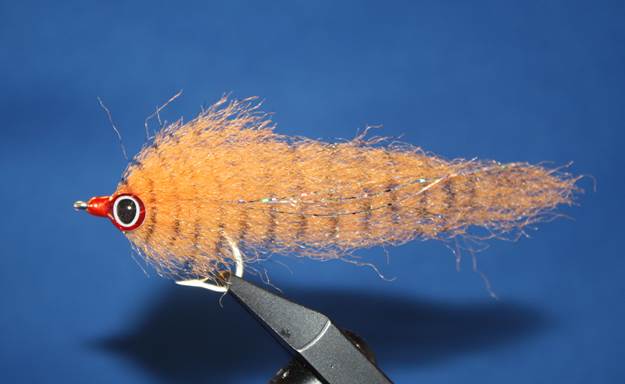
Orange Barred Sailcat Special
- Hook: Mustad 3407
- Sizes: 4/0 to 6
- Thread: Orange A
- Wing/Body: Orange EP Fibers with four strands of Silver Holographic Flash placed in the middle of the wing
- Belly: Orange EP Fibers
- Eyes: 3D-Red with white ring and Black centers, applied with epoxy
Once the pattern is complete comb it out and trim to shape and then mark the entire wing/body and belly with black barring using a Sharpie marker.
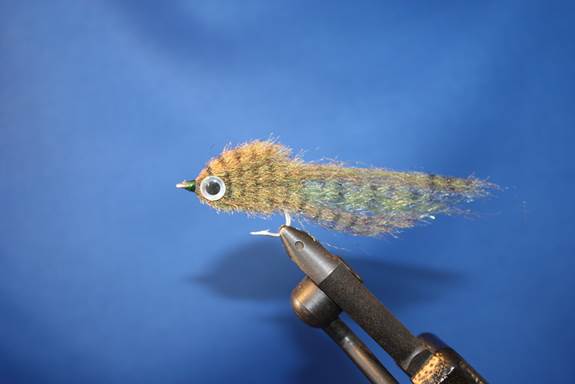
Olive Barred Sailcat Special
- Hook: Mustad 3407
- Sizes: 4/0 to 6
- Thread: Olive A
- Wing/Body: Olive EP 3D Fibers with four stands of Silver Holographic Flash placed in the center of the wing
- Belly: Olive EP 3D Fibers
- Eyes: 3D Silver with Black centers, applied with epoxy
As stated before, comb out, trim and make the barring with a black Sharpie marker.

Yellow & White Jointed Popper
- Hook: Mustad 34007
- Sizes: 4/0 to 6
- Thread: White A
- Popper Head: Yellow Cone Foam type, placed on a Black Barrel Swivel, you attach the barrel swivel to the hook using a spilt ring. Also there are many colors and styles of Popper, Slider and Fluted Chugger style heads that will work the choice is yours. Eyes are optional and 3D type eyes can be applied with epoxy.
- Tails: White Calf tail
- Body: White Trilobal Hackle wrapped.
Note: These jointed poppers are easy to construct and can be tied in a variety of colors and they work on a lot of saltwater and freshwater species.
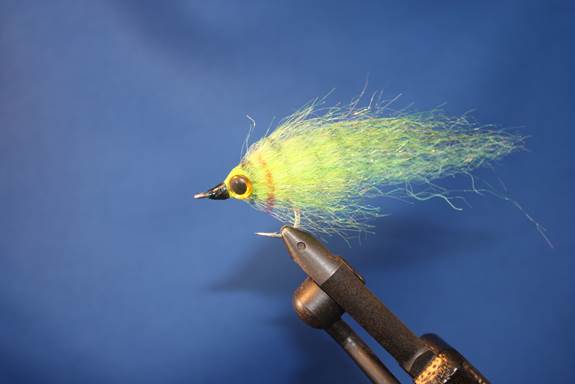
Jack C Special Streamer
- Hook: Tiemco 800S
- Sizes: 3/0 to 6
- Thread: Green A
- Wing/Body/Belly: Chartreuse Farrar's SF Flash Blend
- Eyes: 3D Yellow with Black centers applied with epoxy
All of the patterns listed in this installment are effective on many different speices in the saltwater.
Enjoy & Good Fishin'
| Sysadmin Note |
|---|
| Part 9 can be found here |
